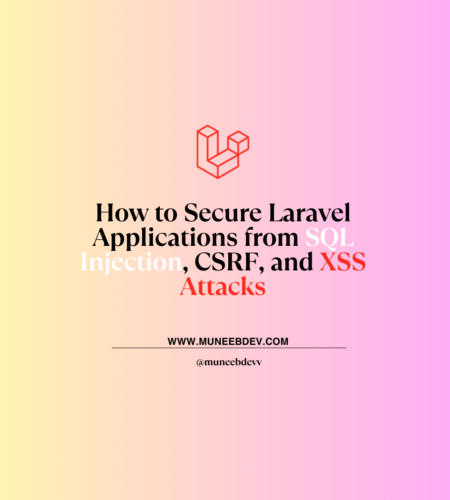Introduction
Security is a critical aspect of web application development. Laravel, a popular PHP framework, provides built-in mechanisms to prevent security vulnerabilities. However, improper coding practices can still expose applications to serious threats such as SQL Injection, Cross-Site Request Forgery (CSRF), and Cross-Site Scripting (XSS) attacks.
In this comprehensive guide, we will explore the best practices to secure Laravel applications against these threats with examples and SEO-friendly explanations.
1. Preventing SQL Injection in Laravel
SQL Injection occurs when an attacker manipulates input data to execute arbitrary SQL queries. This can lead to unauthorized data access, modification, or deletion.
Use Eloquent ORM to Prevent SQL Injection
Eloquent automatically protects queries by binding parameters securely:
$user = User::where('email', $email)->first();Use Query Builder with Parameter Binding
Laravel’s query builder prevents injection by default:
$user = DB::table('users')->where('email', $email)->first();Avoid Raw SQL Queries Without Bindings
Directly using raw SQL queries without parameter binding is dangerous:
// UNSAFE
$user = DB::select("SELECT * FROM users WHERE email = '$email'");Instead, use safe parameter binding:
// SAFE
$user = DB::select("SELECT * FROM users WHERE email = ?", [$email]);2. Protecting Against CSRF (Cross-Site Request Forgery)
CSRF attacks trick users into performing unintended actions on a web application where they are authenticated.
Use Laravel’s Built-in CSRF Protection
Laravel includes CSRF protection by default. Always use @csrf in forms:
<form method="POST" action="/submit">
@csrf
<input type="text" name="name">
<button type="submit">Submit</button>
</form>CSRF Protection in AJAX Requests
Include the CSRF token in AJAX requests:
$.ajax({
url: "/submit",
type: "POST",
data: {
name: "John Doe",
_token: "{{ csrf_token() }}"
}
});Excluding Routes from CSRF Protection (Only If Necessary)
For API endpoints, you may exclude certain routes in app/Http/Middleware/VerifyCsrfToken.php:
protected $except = [
'webhook/stripe',
];3. Preventing XSS (Cross-Site Scripting)
XSS attacks inject malicious JavaScript into web pages, which can steal user data or deface websites.
Escape Output in Blade Templates
Laravel automatically escapes output to prevent XSS:
<p>{{ $user->name }}</p> <!-- Safe -->Avoid {!! !!} for Untrusted Data
Using {!! !!} allows raw output and is unsafe:
<p>{!! $user->bio !!}</p> <!-- UNSAFE -->Instead, use:
<p>{{ e($user->bio) }}</p> <!-- Safe -->Sanitize User Input Before Storing
Strip unwanted HTML tags before saving user input:
$cleanInput = strip_tags($request->input('comment'));Implement Content Security Policy (CSP) Headers
CSP prevents inline scripts from executing:
header("Content-Security-Policy: default-src 'self'; script-src 'self' https://trusted.cdn.com;");4. Additional Security Best Practices
Keep Laravel and Dependencies Updated
Regular updates patch security vulnerabilities:
composer updateForce HTTPS for Secure Data Transmission
Enable HTTPS in .htaccess:
RewriteCond %{HTTPS} off
RewriteRule ^(.*)$ https://%{HTTP_HOST}%{REQUEST_URI} [L,R=301]Or enforce HTTPS in Laravel:
\URL::forceScheme('https');Secure Form Validation
Always validate user input to prevent malicious data submission:
$request->validate([
'name' => 'required|string|max:255',
'email' => 'required|email|unique:users',
'message' => 'required|string'
]);Secure Routes with Middleware
Restrict route access using authentication middleware:
Route::middleware(['auth'])->group(function () {
Route::get('/dashboard', [DashboardController::class, 'index']);
});Secure Cookies
Enable secure cookies in config/session.php:
'secure' => env('SESSION_SECURE_COOKIE', true),
'http_only' => true,Conclusion
By following these security best practices, you can safeguard your Laravel applications from SQL Injection, CSRF, and XSS attacks:
- Use Eloquent and Query Builder to prevent SQL Injection.
- Always include CSRF tokens in forms and AJAX requests.
- Escape output in Blade templates to prevent XSS.
- Keep Laravel and dependencies updated.
- Use HTTPS, validation, and security headers for additional protection.
Security is a continuous process, so stay proactive and regularly audit your application.


Comments